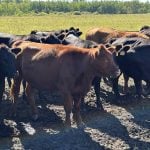Western Canadian feeder cattle markets were unchanged from week-ago levels. Larger pre-sort calf sales were held across the prairies. Buying interest was barely sufficient to support the market at the current levels. The risk tolerance shifted from medium to low this past week. Discounts appeared to be more severe on unweaned and unvaccinated calves. Colder temperatures are in the forecast and feedlot orders contained a shopping list of features with price constraints. Pen conditions haven’t improved in Alberta and feedlot operators know they’ll have to provide extra care on incoming replacements. Fleshier cattle are coming on stream at this time of year which also contributed to the defensive tone, especially in the heavier weight categories.
Read Also

China imports no US soybeans in September for first time in seven years
China imported no soybeans from the U.S. in September, the first time since November 2018 that shipments fell to zero, while South American shipments surged from a year earlier, as buyers shunned American cargoes during the ongoing trade dispute between the world’s two largest economies.
There were limited yearlings on offer but quality packages were well bid. In Central Alberta, mixed larger frame medium flesh steers weighing just under 950 pounds were valued at $193 while red white-faced heifers with very little butter averaging 960 pounds reportedly sold for $173. In Southern Alberta, Simmental blended fleshier steers weighing 835 pounds were valued at $186. In Central Manitoba, Charolais based steers weighing just over 800 pounds were quoted at $188.
Calf prices were quite variable across the prairies. Vaccinated unweaned mixed steers averaging 510 pounds were quoted at $236 in Southern Alberta; unvaccinated unweaned black steers averaging 525 pounds in Southern Manitoba were quoted at $218. In Central Alberta, vaccinated weaned Charolais blended steers weighing 700 pounds were valued at $203 while similar quality heifers averaging 750 pounds reportedly sold for $183.
Notice the October 2020 feeder cattle futures are trading at a $7 premium to the January contract. There were instances were 400 to 500-pound calves traded $4 to $5 above week-ago levels. Without going into detail, there are ideas that yearling numbers next fall will be rather snug due to the year-over-year decline in the 2019 Canadian and U.S. calf crops.
The 2019 Ontario corn harvest is only 20 per cent complete. This delayed harvest is coming on the heels of a very tight corn carryout. Alberta barley prices jumped $10 to $15 last week. Approximately four to eight per cent of the barley crop may remain out in the field over the winter so stocks are not as burdensome as earlier expected. Finally, cattle feeders have experienced significant equity erosion over the past six months. All these factors are straining nerves. As one feedlot operator stated, ‘I’m on my last leg and it’s starting to wobble; if the buyer can’t get the cattle where I need them, I’ll just feed lower numbers this year”.












